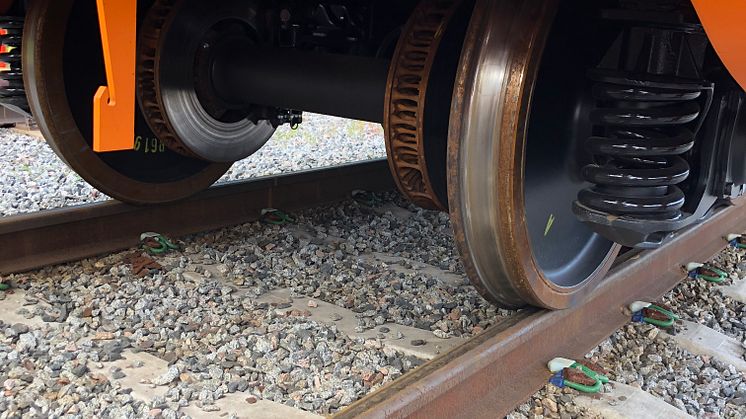
Press release -
Green Cargo and SSAB implement innovative solutions for steel traffic
A technological shift is afoot for wagons and load carriers for specialized freight transport for the SSAB stretches between Luleå and Borlänge and Borlänge and Oxelösund. A total of 40 new wagons have been leased from the wagon provider Wascosa. The wagons, that were constructed by the wagon manufacture Tatravagónka in Slovakia, are equipped with disc brakes that allow for quieter trains, greater flexibility of wagon usage, increased safety when faced with winter conditions and a reduction in maintenance requirements. The assembly of a new type of load carrier on the wagons that is intended to transport steel products is currently ongoing at Green Cargo’s maintenance depot in Eskilstuna.
This involves mounting a cassette on different types of wagons and has been trialed for some time on the Viking wagon for the southern stretch between Borlänge and Oxelösund with satisfying results. The cassette solution creates the opportunity for greater flexibility in wagon usage and allowing the use of wagons that are not typically used for steel products. The wagons designed for trains transporting steel can also be used to transport other types of goods when required. It is also possible to fix a container to a wagon for the transport of, for example, scrap goods.
“Brake technology for the new wagons is the greatest technological development in this area. Disc brakes are used instead of brake blocks. This means that we are using technology that meets EU requirements for quiet freight wagons while we escape the problem of the transition from cast iron blocks to blocks of composite material that have a reduced braking performance,” says Erik Hedlund, Rail Safety Developer at Green Cargo.
Fitting disc brakes to wagons is a tried and tested technology that we at Green Cargo have previous operating experience of, including from our NRE trains between Narvik and Oslo that have been operating for nearly one year. In our experience, the disc brakes have proven very effective and optimal compared with wagons fitted with brake blocks, particularly when faced with winter conditions. The brakes come with properties that prevent ice and snow from negatively impacting the bogies compared with traditional brakes that have many moving parts. Wagons with disc brakes have also been used for the transportation of steel for some years, again with favorable results.
Another innovation that is being tested is to cover the bogies with a coating. The purpose of the coating is to prevent ice and snow from accumulating on the chassis in winter conditions, an issue that effects the running of the trains and increases the need for equipment maintenance.
We asked Carl Stjärnesund, Green Cargos key account manager for SSAB, how the changes will affect steel traffic and our partnership with SSAB:
“Before the current agreement period, we chose to make this investment together with SSAB that provides us with the opportunity to carefully evaluate these wagons in regular traffic for an extended period with regard to cost-efficiency, quality of operations and accessibility. The entire modular solution is also very interesting and we envisage great opportunities for increasing business benefit thanks to its increased flexibility.”
Dan Nordqvist, responsible for SSAB’s Transport Systems, what expectations do you have for the new wagons?
“We have great expectations for these wagons and with the operating evaluation that we have agreed on with Green Cargo, we are now able to use experience-based data to make a decision on a future major technological shift across the entire wagon fleet for the transportation of steel. The years to come will be informative in providing us with comprehensive insight for different brake and wagon technologies.”
Bjarke Raaby, vehicle engineer at Green Cargo’s Wagon Unit, you are heavily involved with the introduction of the new wagons. What do you believe are the greatest advantages of the new technology?
“There are many major advantages. We are now entering an extensive follow-up program where the wagons will be running at full capacity around the end of the year. The hope is that the program will lead to fewer damaged wheels, cheaper maintenance and a more stable operation.”
 |
| New disc brakes for quieter trains, more flexible wagon use, increased safety in winter conditions and less need for maintenance. |
Topics
Categories
- innovation
- steel
- sustainability
- Green Cargo
- SSAB
- railway
- freight transport
- high quality
- innovation and development
- flexibility
- cost-efficiency
- rail freight
- customer cooperation
- wagon load
- climate-smart transportation
- Wascosa’s wagon
- load carrier
- Brake technology
- transportation of steel
- wagon technology
Green Cargo is a sustainable logistics partner and crucial for Scandinavia’s trade and industry. Electric trains make up over 95 percent of our ton kilometrage, meaning the climate impact is next to zero. Every 24 hours, some 400 freight trains depart, replacing around 9,000 truckloads on the road network. We serve close to 300 locations in Sweden, Norway and Denmark through our network, and with our partners we reach all of Europe. Green Cargo is owned by the Swedish State. We transport 22 million tonnes of freight, have 1,800 employees and annual sales of about SEK 4.1 billion (2019). www.greencargo.com




